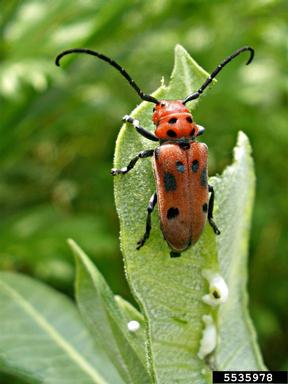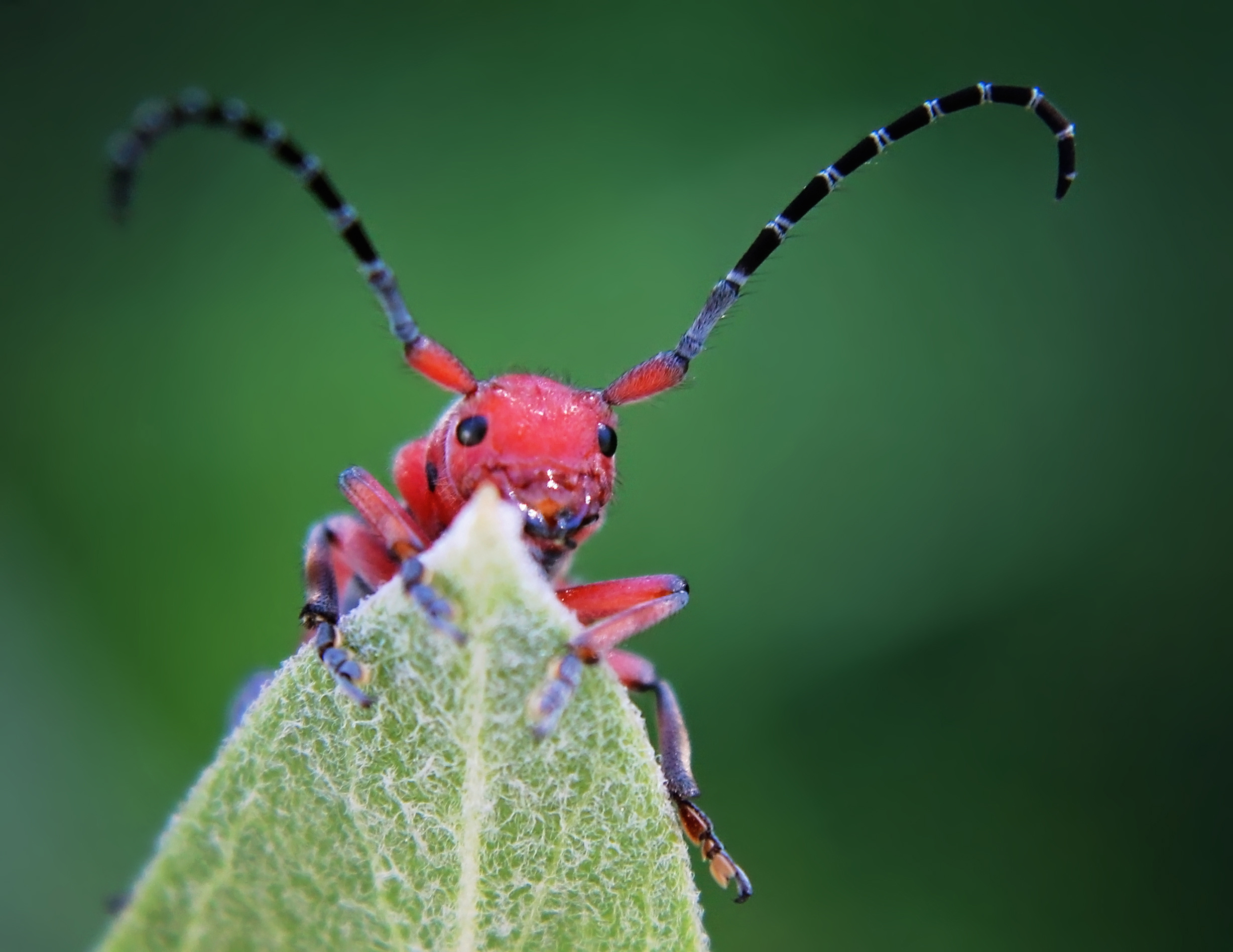Milkweed Beetles
By Joyce Fry
What prompted me to research milkweed beetles was the failure to thrive status of my swamp milkweed (Asclepias incarnata). Last year I did notice that something was a little amiss with it, although it was surprisingly robust for its second year. The plant grew to a height of just under 4 feet with stalks bearing numerous clusters of dazzling pink flowers and spreading to a diameter of about 3.5 ft. But a few leaves here and there drooped. Because the plant was so productive, I didn't examine it, and besides, the plant had hosted at least 21 monarch caterpillars. This year, however, the plant has vastly underperformed, as it never grew to more than about a foot tall and its uppermost leaves drooped at that height. Alarmingly, it didn’t produce any buds. Finally, I realized that it had a serious problem. Upon close inspection of one of the drooping leaves with a triplex hand magnifier, it became clear that the spots on the petiole beneath the wilted section of the leaf were holes. With the naked eye, one might’ve mistaken them for scale or some other tiny insect. Adam Leonberger, Franklin County Extension Agent, stated that the damage was most likely caused by a red longhorn milkweed beetle (Tetraope tetrophthalamus). Of the 12-15 species of milkweed longhorn beetles in the United States, only three species are found in the east, all in the Genus, Tetraope (pronounced “te truh ope,” with the “o” pronounced as a long vowel). The genus name is Latin for “four eyes,” as does the species name, tetrophthalamus. There are only two, but each eye is divided by an antenna, so it appears to have four. Besides for T. tetrophthalamus, which is the most common of the trio, there is a blackened milkweed longhorn beetle (T. melanurus) and a red-femured milkweed longhorn beetle (T. femoratus). As their common name implies, milkweed plays a prominent role in their life cycle. Beetles undergo complete metamorphosis i.e., egg, larva, pupa and adult. The female adult milkweed longhorn beetle lays her eggs near the base of a milkweed plant in the spring. As a larva, known as a round-head borer, it eats through the plant stem or roots, leaving a tunnel behind in which it overwinters. In the spring, the larva pupates in the tunnel, emerging as an adult in summer just as the buds and flowers appear. The milkweed beetle adult feeds upon them as well as the plant’s leaves. The holes? By biting a hole in the leaf vein below where it is feeding, the latex will drain out and not gum up its mouthparts! Ingenious!

Red Longhorn Milkweed Beetle
I also found that there is a swamp milkweed leaf beetle (Labidomera clivicollis), which also cuts a hole in the leaf before feasting, and this one is particularly fond of swamp milkweed. All milkweed beetles are beautifully and stunningly marked with bright red, orange or yellow colors and black or dark blue spots. The prominent bright colors serve as a warning to would-be predators that they taste bitter, which is due to the cardiac glycosides they ingest from feeding on milkweed. This warning is called “aposematism,” and can also be observed in monarch butterflies (Danaus plexippus) and its close look alike, the viceroy butterfly (Limenitis archippus) as well as the milkweed bugs (Oncopeltus spp.). In fact, there are at least 100 insect species that exhibit this trait, which is advantageous to both predators and prey.
Now, what to do? My options are limited. Pesticides are off the table; besides killing beetles, they would kill monarch butterfly larvae and other unintended insects. Other options I have found include dousing them with soapy water, spraying them off with a hose, or hand-picking. I haven’t seen any beetles, so those options are out, too. One article I found suggested planting additional swamp milkweeds nearby. That can work over time because insects experience boom and bust cycles. “Booms” in an insect population occur when weather and food availability are favorable to their population growth. Conversely, when conditions are less favorable, the insect population “busts.” If the beetles prefer swamp milkweed, it is likely that next year will be a bust, at least in my garden, because that is the only swamp milkweed nearby. Meanwhile, I’m just enjoying the rest of the plants in my gardens, including the orange, common and whorled milkweeds (A. tuberosa, A. syriaca, and A. verticillata, respectively).


